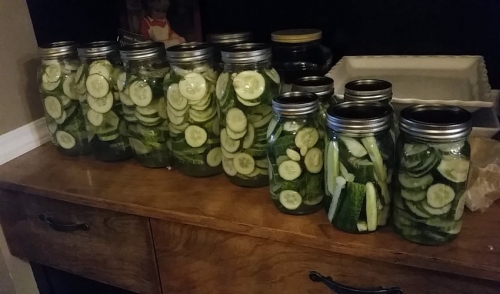
Canning 101
Canning is a very simple task and a great DIY project. The purpose of canning is to kill any microorganism that can spoil food, and to seal the jar tight enough to keep microorganism out. This is why canning requires a lot of cleanliness, sterilization, and hygiene. It’s safer and more efficient than any refrigerator, freezer, and Ziploc bag.
You can ‘can’ almost any food. There are two techniques you can use to can food: water bath and pressure canning. Most foods need to be canned safely under high temperature and high-pressure conditions, whereas acidic foods that have a pH less than 4.6 can be preserved in jars by using hot water baths. Water bath canning is typically used for canning more acidic foods like pickles, tomatoes, and fruit jams. Water bath canning involves a large cooking pot, with a tight fitting lid and a wooden rack or wire that keeps the jars from touching each other. The wooden rack or wire will allow the boiling water to flow around and underneath jars so that the contents in each jar are evenly processed. The rack will also keep the jars from bumping each other reducing the chances of cracking or breaking. Clean cotton dishtowels may also be used to pack around jars to reduce bumping. If you do not have a standard canner, any large metal container that is deep enough to boil and cover the jar will suffice. Before you begin this process, make sure the diameter of your metal container or canner is no more than 4 inches wider than the diameter of your stoves burner to guarantee proper heating of all jars. The second technique to canning and preserving is pressure canning. Pressure canning involves a specially made heavy pot with a lid that can be sealed steam tight. The lid of the pressure canner is fitted with a vent, a weighted pressure gauge, and a safety fuse. The pressure canner also contains a rack. However, because each type of pressure canner is different, be sure to read the directions before operating. Finally for both canning and preserving techniques, use the right jars. Ball jars and Mason jars that are specifically designed for canning at home are your best choices. Avoid using commercial mayonnaise jars, baby food jars, pickle jars, and other processed food jars. These are not sterile and are not suitable for high pressure or boiling water temperature. Mason jars and ball jars come in a variety of sizes and if properly used, may be reused indefinitely. Additionally, use a two-piece self-sealing lid, which consists of a flat metal disc with a rubber-type sealing around the outer edge and a screw-type metal band. The flat self-sealing lid can only be used once, but the screw band can be used indefinitely as long as it is kept in good condition.
Label your jars with the date or year it was sealed. Make sure to store all sealed jars away from excessive light exposure, and of course refrigerate after opening.
